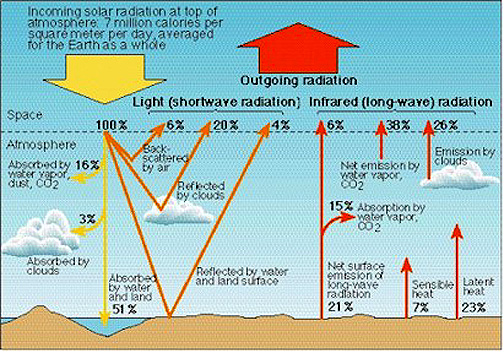What is the greenhouse effect and how is it related to global climate change?
2 Answers
The greenhouse effect is where solar energy enters the atmosphere and is prevented from leaving by certain gases that work the same way that glass on a greenhouse does.
Explanation:
The energy from the sun enters the atmosphere as short wave radiation. Radiation in this form passes through gases like carbon dioxide as if it was not there. This radiation reaches the ground and is absorbed, which heats up the ground.
Heat you can feel is long wave radiation. The ground releases this long wave radiation back into the atmosphere which is what actually heats it (you thought the sun did?). The trouble is this long wave radiation does not pass through carbon dioxide as if it is not there. The carbon dioxide traps this heat.
In order for the Earth to maintain a constant temperature, it has to release as much energy as it receives from the Sun. This is called the Solar Balance and it looks like this:
The yellow numbers represent short wave radiation and the red ones long wave.
If you add up all the outgoing radiation numbers you will see the add up to 100% (the 8, 17,6 etc. at the top of the page).
If you look close to the middle of the page you will see the number 6. That represents the amount of heat retained by greenhouse gases. Now if that number increase, to say 7, because the amount of greenhouse gas increases then the 9 at the top becomes 8. That means that we need to release 1 more long wave radiation before we are in balance again. What happens is the atmosphere heats up (global warming) and the 20 at the top becomes 21 (atmosphere releases more heat after it get warmer).
I hope this is understandable.
The increased emissions of greenhouse gases, imbalances the energy budget between the Earth and Sun.
Explanation:
Greenhouse gases allow sunlight to pass through them but prevent heat from passing through them. This has been explained many times already here so I am not going to explain that again.
This is how the energy budget between the Earth and Sun looks.

Notice that the incoming solar energy is 100%. If you add the 6% reflected by the atmosphere (oddly enough this greenhouse gases preventing radiation in the infrared or heat spectrum from entering the system), 20 % reflected by clouds, 4% reflected by the Earth's surface, 64% radiated from clouds and atmosphere and the 6% radiated directly from the Earth you will get 100%. This is balanced then.
If you look at the 15% that is absorbed by water vapor and carbon dioxide. That amount is actually what is absorbed by greenhouse gases (carbon dioxide and water vapor are the most abundant greenhouse gases by far). If that number increased to say 16%, the the amount radiated directly from the Earth would drop for 6% to 5%, and we would no longer have a balance.
In order to get back into balance then the surface of the Earth has to warm up. If the Earth is warmer then the 7% sensible heat (heat you can feel) can increase to 8%, and then the outgoing radiation
will once again equal 100%.
That is what is happening when the greenhouse gas emission increase enough. The end result is an increase in heat. The main problem with that is not that it is happening, since climate change is normal, but the speed that it is happening. The rapid change in climate due to human activities is happening a a rate that is too fast for some animals to evolve with, and mankind might be one of those animals.

